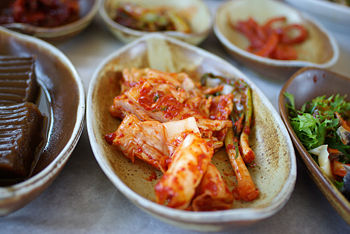Kimchi: Difference between revisions
imported>Chunbum Park |
imported>Chunbum Park |
||
| Line 13: | Line 13: | ||
== Types and regional varieties == | == Types and regional varieties == | ||
The most prevalent type of kimchi today is the ''baechu'' kimchi, containing [[Chinese cabbage]]. The Chinese cabbage was imported from China around 1850, and cabbage kimchi began to appear only by the end of the 19th century.<ref name="natekimchi">[http://100.nate.com/dicsearch/pentry.html?s=K&i=240991&v=44 김치] [ kimchi ], | The most prevalent type of kimchi today is the ''baechu'' kimchi, containing [[Chinese cabbage]]. The Chinese cabbage was imported from China around 1850, and cabbage kimchi began to appear only by the end of the 19th century.<ref name="natekimchi">[http://100.nate.com/dicsearch/pentry.html?s=K&i=240991&v=44 김치] [ kimchi ], Britannica Korea, Cultural Heritage Administration of Korea, and the Academy of Korean Studies. ''네이트 백과사전'' [ Nate Encyclopedia ].</ref> | ||
"Summer kimchi" is made from leaves and cores of the [[cabbage]] family, while "winter kimchi" is based on white [[radish]]es of the [[daikon]] family. | "Summer kimchi" is made from leaves and cores of the [[cabbage]] family, while "winter kimchi" is based on white [[radish]]es of the [[daikon]] family. | ||
Revision as of 22:58, 30 June 2009
Kimchi (김치), also transliterated as "kimchee", is a family of Korean vegetable-based pickles. As a side dish, they are a basic part of Korean cuisine, with many variants, although usually strongly flavored, featuring garlic and hot peppers. Kimchi is also a key ingredient for Korean dishes such as kimchi stew and kimchi pancake, and it is often eaten by Koreans with ramen noodles and gimbap rolls. Kimchi is generally considered very healthy due to its lactic acid bacterias, antioxidants, and high fiber content. Although it is widely accepted that the advantages of eating kimchi include improved digestion and bowel function, other benefits, such as increased immunity and reduced chance of cancer, are disputed due to contradicting studies or lack of concrete evidence.[1] Regardless, the Health Magazine listed kimchi as one of the five healthiest foods in the world in 2008.[2]
History
The kimchi has its roots in the salted vegetables that were preserved as a source of food during the winter months. This practice existed in China and Korea some 3,000 years ago, and its method was later transferred to Japan by the Koreans from Baekje during the Three Kingdoms Period.[3] Accordingly it is theorized that the Koreans originally called the dish chimchae, meaning "the salting of vegetable." The name underwent several phonetic changes over the centuries, to timchae, dimchae, jimchi, and finally kimchi.[4][5]
Kimchi was first mentioned in the historical texts from the Goryeo Dynasty, including guidelines and conventions that detailed a list of kimchi types that were necessary for ancestral rituals. Its appearances in a number of poems from the 13th century to the 15th century indicate that it was widely consumed among the Koreans since this time. The "chimchae" during this period generally consisted of one or two vegetables that were preserved in salt. A new type of kimchi that became popular was the dongchimi, which consisted of pickled radish in salt water and also contained the soup from pickling.[6] A medical journal from this time period listed the vegetables that were mainly used to make kimchi, such as cucumber, wax gourd, garlic chives, curled mallow, lettuce, green onion, and radish.[7]
By the early period of the Joseon Dynasty, kimchi had evolved to contain various seasonings, which were first mentioned in a poem written by Seo Geojeong. For many commoners during this time, kimchi was in fact a main dish and not merely a side dish.[6] The kimchi around this time was called "dimchae," and it was significantly different from the modern kimchi. The kimchi today is largely characterized by the red pepper and the salted seafood, which allows for a substantially lower salt content. The red pepper was introduced from Japan in the early 1600s, and a variety of salted seafood existed since the Three Kingdoms Period, but these two ingredients would be applied to kimchi only after the mid-1700s.[7]
Types and regional varieties
The most prevalent type of kimchi today is the baechu kimchi, containing Chinese cabbage. The Chinese cabbage was imported from China around 1850, and cabbage kimchi began to appear only by the end of the 19th century.[8]
"Summer kimchi" is made from leaves and cores of the cabbage family, while "winter kimchi" is based on white radishes of the daikon family.
Notes
- ↑ Koreans’ Kimchi Adulation, With a Side of Skepticism, Barbara Demick, Los Angeles Times, 2006-05-21.
- ↑ "World’s Healthiest Foods: Kimchi (Korea)", Joan Raymond, Health Magazine. 2008-02-01.
- ↑ 김치의 변천사 [the history of kimchi], Pulmone Kimchi Museum. 2007-10-08.
- ↑ History of Kimchi, Korea Sparkling. Date accessed: 2009-03-10
- ↑ Kimchi, the fundamental Korean food, Korea Sparkling. Date accessed: 2009-03-10
- ↑ 6.0 6.1 In spices and vegetables, the essence of Korea, Cho Jae-eun, JoongAng Daily. 2007-05-28.
- ↑ 7.0 7.1 Kimchi, Koreana. Winter 2008.
- ↑ 김치 [ kimchi ], Britannica Korea, Cultural Heritage Administration of Korea, and the Academy of Korean Studies. 네이트 백과사전 [ Nate Encyclopedia ].
